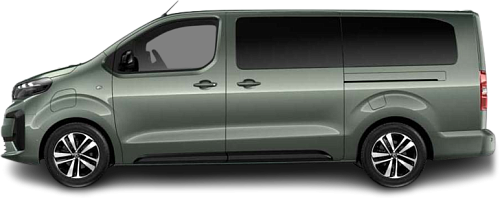USA EV Comparison: Citroën e-Jumpy Combi M 50 kWh vs Peugeot e-Traveller L2 50 kWh
Struggling to Decide? Let AI Help!
Your AI Summary Is Ready!
General Info
While the Peugeot e-Traveller L2 50 kWh (2024-...) is currently produced, it is not offered for sale in the United States. The Citroën e-Jumpy Combi M 50 kWh (2020-2024) has been discontinued, it was never offered for sale in the United States.
The two vehicles share the same body style: Minivan.
| Property | Citroën e-Jumpy Combi M 50 kWh | Peugeot e-Traveller L2 50 kWh |
|---|---|---|
| Years of Production | 2020-2024 | 2024-… |
| Current Status | Discontinued | Produced |
| Country of Manufacture | France, Turkey, UK | France, Turkey, UK |
| Body Style | Minivan | Minivan |
| Market Availability | EU | EU |
| GCC Score | 5 | 5.2 |
Range and Efficiency
Although both cars have the same battery capacity, Citroën e-Jumpy Combi M 50 kWh (2020-2024) achieves a longer real-world range due to its superior energy efficiency.
| Property | Citroën e-Jumpy Combi M 50 kWh | Peugeot e-Traveller L2 50 kWh |
|---|---|---|
| Range (WLTP) | 141 mi | 139 mi |
| Range (GCC) | 122 mi | 119 mi |
| Battery Capacity (Nominal) | 50 kWh | 50 kWh |
| Battery Capacity (Usable) | 46.3 kWh | 46.3 kWh |
| Efficiency per 100 mi | 38 kWh/100 mi | 38.9 kWh/100 mi |
| Efficiency per kWh | 2.63 mi/kWh | 2.57 mi/kWh |
| Range and Efficiency Score | 3.1 | 2.8 |
Charging
Both vehicles utilize a standard 400-volt architecture.
Both vehicles support DC fast charging with a maximum power of 101 kW.
The Peugeot e-Traveller L2 50 kWh (2024-...) features a more powerful on-board charger, supporting a maximum AC charging power of 11 kW, whereas the Citroën e-Jumpy Combi M 50 kWh (2020-2024) is limited to 7.4 kW.
| Property | Citroën e-Jumpy Combi M 50 kWh | Peugeot e-Traveller L2 50 kWh |
|---|---|---|
| Max Charging Power (AC) | 7.4 kW | 11 kW |
| Max Charging Power (DC) | 101 kW | 101 kW |
| Architecture | 400 V | 400 V |
| Charge Port | CCS Type 2 | CCS Type 2 |
| Charging Score | 4.3 | 5.4 |
Performance
Both vehicles are front-wheel drive.
Both cars offer the same motor power, but the Citroën e-Jumpy Combi M 50 kWh (2020-2024) achieves a faster 0-60 mph time.
| Property | Citroën e-Jumpy Combi M 50 kWh | Peugeot e-Traveller L2 50 kWh |
|---|---|---|
| Drive Type | FWD | FWD |
| Motor Type | PMSM | PMSM |
| Motor Power (kW) | 100 kW | 100 kW |
| Motor Power (hp) | 134 hp | 134 hp |
| Motor Torque | 192 lb-ft | 199 lb-ft |
| 0-60 mph | 12.1 s | 12.8 s |
| Top Speed | 81 mph | 81 mph |
| Performance Score | 2 | 1.9 |
Dimensions
The Citroën e-Jumpy Combi M 50 kWh (2020-2024) and Peugeot e-Traveller L2 50 kWh (2024-...) are about the same size.
Both models have similar wheelbase lengths.
| Property | Citroën e-Jumpy Combi M 50 kWh | Peugeot e-Traveller L2 50 kWh |
|---|---|---|
| Length | 195.1 in | 196.2 in |
| Width (with Mirrors) | 86.8 in | 86.8 in |
| Width (w/o Mirrors) | 75.6 in | 75.6 in |
| Height | 74.4 in | 74.4 in |
| Wheelbase | 128.9 in | 128.9 in |
Cargo and Towing
The Peugeot e-Traveller L2 50 kWh (2024-...) provides more cargo capacity, featuring both a larger trunk and more space with the rear seats folded.
Neither car is equipped with a frunk (front trunk).
The Peugeot e-Traveller L2 50 kWh (2024-...) is better suited for heavy loads, offering a greater towing capacity than the Citroën e-Jumpy Combi M 50 kWh (2020-2024).
| Property | Citroën e-Jumpy Combi M 50 kWh | Peugeot e-Traveller L2 50 kWh |
|---|---|---|
| Number of Seats | 9 | 5, 6, 7, 8, 9 |
| Curb Weight | 4341 lb | 4468 lb |
| Cargo Volume (Trunk) | 17.9 ft3 | 21.3 ft3 |
| Cargo Volume (Max) | 108.1 ft3 | 140.1 ft3 |
| Cargo Volume (Frunk) | - Cargo Volume (Frunk) | - Cargo Volume (Frunk) |
| Towing Capacity | 2204 lb | 2205 lb |
| Cargo and Towing Score | 8.7 | 8.8 |




